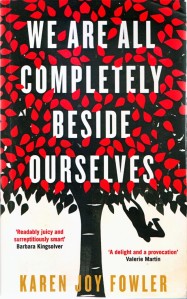 In Karen Joy Fowler’s ingenious novel about the ill-defined line between human and animal nature, We Are All Completely Beside Ourselves (2013), one character is wanted by the FBI for blowing up research labs after freeing the caged animals.
In Karen Joy Fowler’s ingenious novel about the ill-defined line between human and animal nature, We Are All Completely Beside Ourselves (2013), one character is wanted by the FBI for blowing up research labs after freeing the caged animals.
Asked in an interview what she thinks of animal rights–inspired crimes, Fowler says: ‘I believe in science and medical research.’ And it’s the politically correct response in today’s social climate – implying that some studies (experiments) are necessary for human health (presumably conducted ‘humanely’, though of course that’s relative). But Fowler’s probing novel hints at deep ambivalence. And it’s underpinned, if not at all burdened, by her extensive research.
As with the orang-utan in Monkey’s Uncle (1994), a novel about insanity by the late, great Jenny Diski, it’s relevant that Fowler’s simian character is female. Like Diski’s fiction, Fowler’s tends to feature nonconformist women. Given the overlap, now and historically, between exploitation of animals and oppression of women (and non-whites and the poor), why don’t we see more such inventive animal advocacy novels?
Could part of the problem be that animals can’t speak English, write books and essays, or use social media? Instead, humans speak for them, in cartoons, ads etc., reducing them to comics or corporate puppets. Meanwhile, scientists pick their brains, literally, and we eat their flesh (often disguised by euphemisms, processing, batter, sauce or whatever). A few humans speak for them in an attempt to awaken our empathy. Yet the rhetoric of animal libbers can easily be ignored unless their activism rates as news – an excuse for pro-corporate governments to tighten repressive laws.
One of the greatest gifts of a novel (if sometimes underrated in a market favouring entertainment) is the space for readers to empathise or even identify with the other, rather than with the character who most resembles them. Fiction remains one way to reach a wide audience not just through the habitually defensive, separative intellect, but by engaging the more inclusive, compassionate imagination.
Instead of speaking for animals, a common children’s book strategy, Fowler lets readers fill in the gaps. As the human narrator, Rosemary, tries to make sense of her childhood, we learn quite a bit about Fern, her twin, before we know she’s a chimp. (No wonder Rosemary can’t keep her hands to herself, and relates vertically, as well as horizontally, to the world.)
Kafka’s short story ‘A Report for an Academy’ – about an ape who escapes his cage by mimicking human behaviours, and written after Kafka had become a vegetarian – supplies all the epigraphs throughout Fowler’s novel. In his thoughtful Overland article ‘Carrion Call’, Thomas Wilson asks why the vegetarian reading of texts is ignored, compared to postmodern, post-colonial and feminist readings, when all of these share social justice concerns. And Fowler acknowledges this intersectionality: